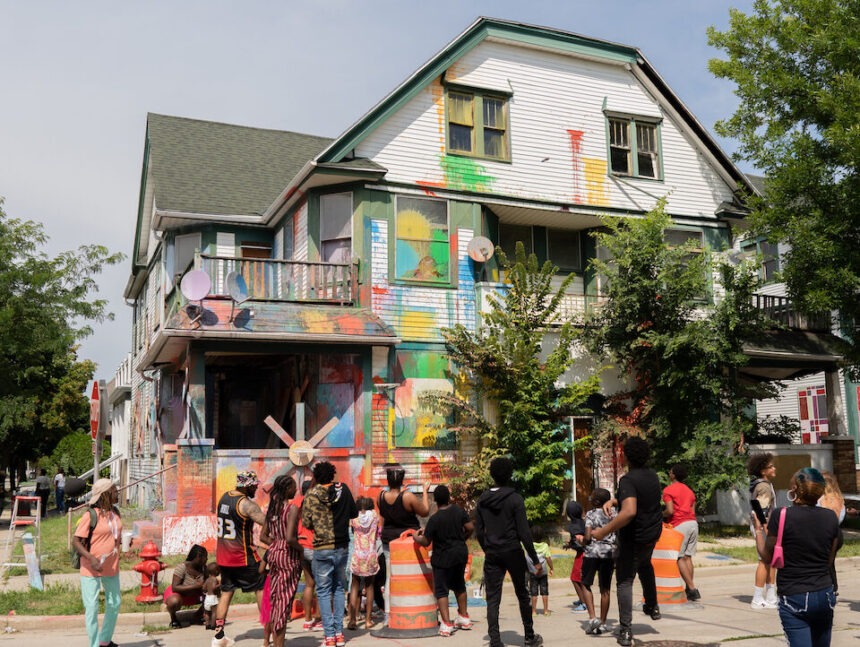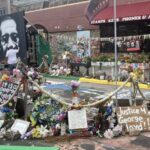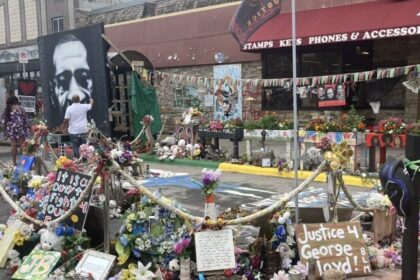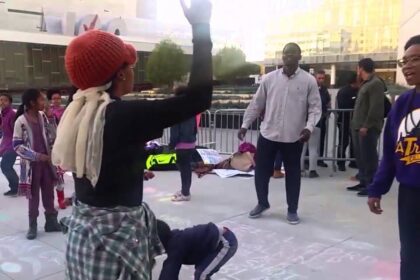Interview with HomeWorks: Bronzeville
Laura Thompson
HomeWorks: Bronzeville is a cultural development project located in the Bronzeville neighborhood of Milwaukee, WI. In 2016, Mikal Floyd-Pruitt, Vedale Hill, and Sara Daleiden founded the organization to renovate and create owner occupied live/work spaces for artists with the intention of cultivating the historic cultural and entertainment distinct. On February 28, 2023, Floyd-Pruitt, Daleiden, HomeWorks collaborator Lexi Brunson, and FIELD editorial collective member Laura Thompson spoke over zoom. The transcript of their conversation is printed below.
Laura Thompson: I would like to begin by asking you about the origins of HomeWorks: Bronzeville. How did the organization get started?
Mikal Floyd-Pruitt: I’m one of the co-owners and co-developers of HomeWorks: Bronzeville along with Vedale Hill and Sara Daleiden. So, the inception of HomeWorks: Bronzeville naturally came out of the experiences that we were having as artists and trying to have spaces to live and work. Sara has space that she has grown as an artist residency, which I participated in. Vedale and his brother Darren run a youth arts nonprofit organization that also provides studio space and opportunities for professional practicing artists. I had studio space with them as well. I started looking at homes as spaces to cultivate our practices. And then as an artist-in-residence at Jazale’s Art Studio, which is the youth arts nonprofit ran by Vedale and Darren, we started cultivating community as well as social and cultural capital [by holding events]. In order to have a space up to code for things we wanted to do, such as having a higher number of people in there, we got an additional bathroom and so forth. But essentially, due to systemic racism, the tenants below us were calling the police on us a number of times for things that were not violations. The police would stop by in the middle of an art show, while my mother would be there with her friends as well as community leaders, board members from different foundations, young people, and art professors showing fine art in our space. It just did not stop being an issue. We got the cops called on us a number of times even though there’d be really no issue. Eventually our landlord, who didn’t live close by…got fed up that the police were being called on the young Black male artists that were working upstairs. We tried to smooth things out by having a meeting with the police department and we really tried to pull all our resources and networks together to stabilize the situation, but in the end our leadership got canceled on all sorts of technicalities that were rather unfair.
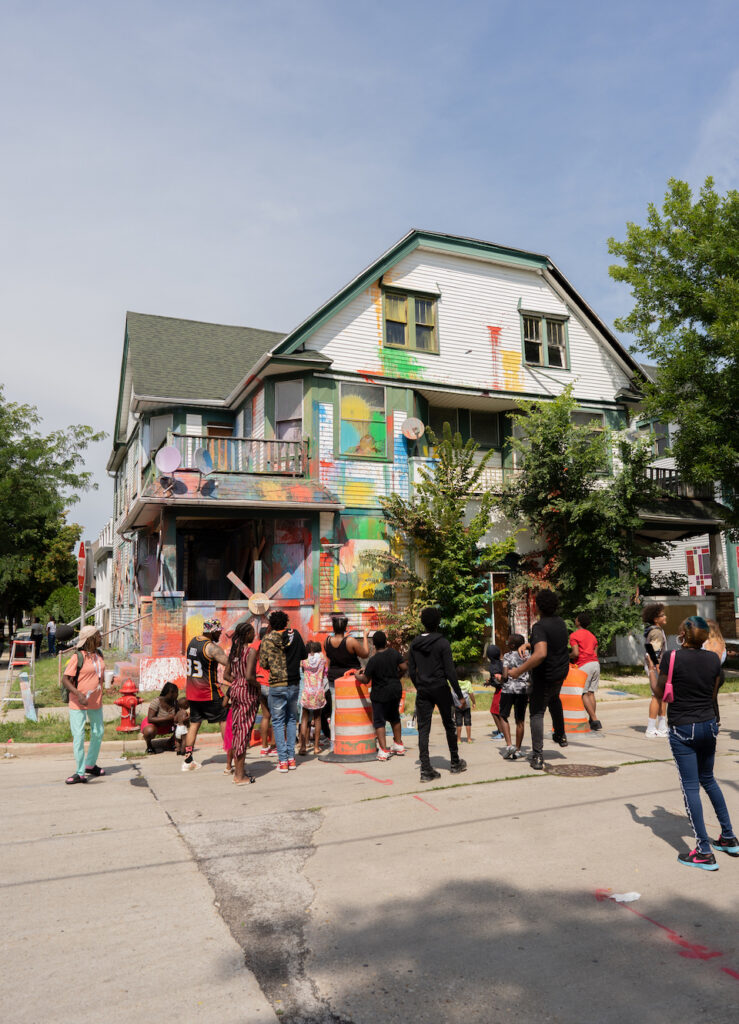
So, we got this place and currently there’s other young artists utilizing the space in the same fashion we had. A lot of the cultural, social, and communal capital got established by being in an art space. A lot of that residue sticks with the location and when we moved, we had to start building that momentum up again. We were fortunately able to move into another space pretty quickly after that. But again, we had to start letting people know where we were, and then we were working with another landlord. So, changes that we wanted to make to the space were slow moving, and it just wasn’t suiting our needs as a studio and fine art space. So, finally, the three of us just got together and decided that we needed to own a property…It takes a lot of work and effort—years of working and doing events to build that social capital and we wanted to retain that. Additionally, the issue of gentrification and ownership was important to us because often artists will move into a neighborhood and activate that area socially, culturally, and then price themselves out. Gentrification starts after that. So, it was important for us to not only retain our cultural capital, but also to retain the spaces so that we’re not pricing ourselves or our neighbors out.
LT: What were your initial goals and have those goals shifted over time?
MFP: Sara, Vedale, and I are artists. We work closely with community, and we have worked closely with each other over several years prior to forming HomeWorks. We’ve worked on a number of neighborhood development initiatives, so we’re known for engaging community with our practices. Now we are real estate developers. We did not start this process as real estate developers, so one of the important steps we took before we started was to sit down with each other and develop a charter that expressed our goals… I think doing that before diving into the realities of real estate development really helped us shape our development practice in a way that is more community centered, holistic, and honestly quite different [from] your average development organization. We have consensus decision making between the three of us, as opposed to voting because we felt like if we can’t agree on important issues, if we can’t come to a consensus about what the ideal way to move forward is, it means we haven’t done the work to actually hammer out what an ideal community is for us. Because that’s how we feel, we feel like we’re constructing community, and that community starts with the three of us moving forward in a way that is holistically focused on developing greater space, developing living space, developing communal space, and developing economic opportunity for ourselves and those around us. And so that charter really became the guiding light of the North Star, or how we would move forward. Sometimes when we’re having conversations with other real estate developers or banks or lawyers looking over a document they say this isn’t how it usually works. But we are doing it like this, because how it usually works doesn’t focus on the people. Instead, it focuses on the technicalities of the deal and flipping the properties. But we are really trying to instill longevity and stability through this project.
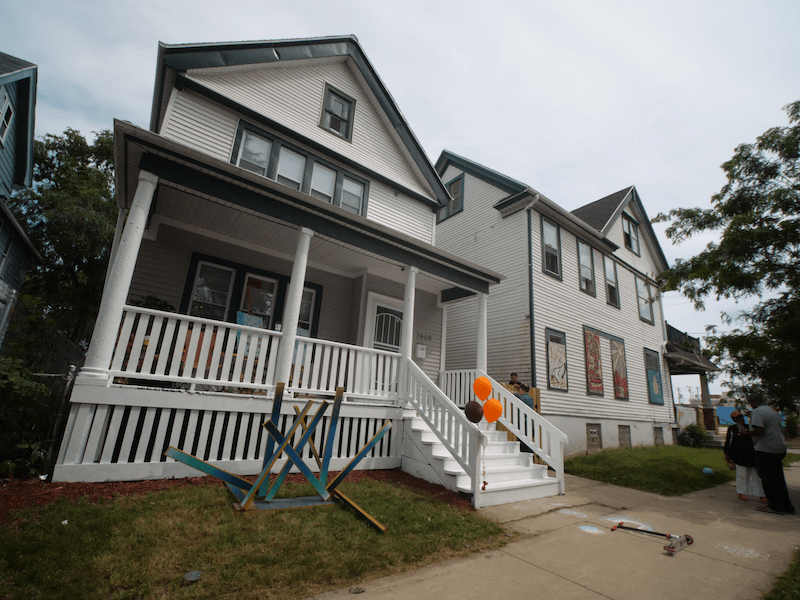
LT: HomeWorks is an ambitious venture with many components. Could you address how one of your completed projects—like 2408 N. Vel R. Phillips Ave. for example—has functioned as an independent entity and as an integrated feature in the neighborhood since it was completed in 2018?
Lexi Brunson: 2408 functions as a gallery and a live/workspace. Vedale is programming this space for how his lifestyle is—how artists make creative space. There is the front-facing Gallery, where events happen, and then different art shows go on in that space. On an everyday basis, it functions as a home where he lives with his family, where he does some of his creative practice. So, there is space to accommodate that. And what that allows for is the artistic lifestyle and the creative person to function together instead of being separated. You can see this activation happening where we’re bringing community into this space. It offers a more authentic approach to how creatives function. It provides the opportunity to live in a space that inspires you to create.
MFP: I would add to that part of our charter is that anyone of us who is involved in Bronzeville should make a commitment to open their practice to the neighborhood in some fashion. And so, depending on what your art practice is, that could work differently. Maybe if you’re a musician, you agree to play some shows for neighbors or you play music out on the lawn or something…We made sure to go around, meet the neighbors and invite them to the different events that we have. That’s a commitment that we had from the start that we are going to continue moving forward with. So, you really get to expose everyone that’s around—who may be interested or may be new to art—to give people in the neighborhood an opportunity to further engage with each other. So that we may build relationships with them in some capacity.
LT: A project of this nature seems to depend on collaboration, not only of individual artists and activists, but also with other local organizations and officials on a city and state-wide basis. Could you talk about this aspect of HomeWorks?
MFP: Our relationship with community organizations, neighborhood organizations, city officials, and different departments within the city has been crucial. Since our inception, we’ve been in close communication with the King Drive BID and certainly with Alderwoman Milele Coggs. [1] She has been instrumental and supportive of our initiative in helping us to communicate our vision and has helped us move through the technical steps of this process. Vedale’s property was the guinea pig or the test run of this process…We worked with Strong Blocks, which is a different development organization that works on helping lower-income families purchase homes. They work on rehabbing properties and work their relationships with banks to structure a rent-to-own process. [This process helps] families—that may not have the strongest credit record—be able to take over the lease from the banks after making a certain amount of payments. After going through that process and trying to shape properties towards our specific usage, we realized that we wanted each space to be tailored towards the artist’s practice, so we were trying to make a lot of changes to the property that would not be involved in your usual rehab. Moving forward on the next set of properties, we have decided to develop the properties ourselves. But along this whole process, our relationship with the city has been instrumental. For example, the ARCH [Art and Resource Community Hub Loan] Program, which offered money allocated by Alderman Coggs, supports the development of artist housing. We were the first group of people to activate that fund. When we requested a $25,000 forgivable loan, it was understood that we would have to utilize the space in the manner intended for five years for it to be forgiven. There was not a process ironed out as to how that money would be dispersed and what requirements we would have to meet… So, we worked closely with the city to figure out the structure that process would take. While we were the first group to activate that fund, there have been other folks that have been able to access it afterwards. It was really a bit of a collaboration to even get that pool of money activated. Having the support of the community and other branches of government looking at zoning changes and other stuff of that nature really helped [as well as] having people who also have goals for the improvement of the community. It was very beneficial for us to understand what their goals were also, so that we could see how our work overlaps with each other’s.
LT: Could you talk about your engagement with the Black Lives Matter movement on an individual and organizational level?
MFP: Vedale and I grew up very close in Milwaukee as two young Black men. Vedale grew up close to the Bronzeville neighborhood that we are working in on the East Side of Milwaukee. He has been in that area since childhood and has family in that area. I’ve lived there at different times in different apartments. Really our experience is…everything that Black Lives Matter is calling for. It’s really important to us in HomeWorks to be providing a foundation for economic opportunity. So, I think that speaks to your question earlier on what our goals are. One of our main goals is for there to be a cluster of properties around each other to start to make a creative network that has stability through ownership. In this way, we can start to develop the bones of a connected, creative industry that is also communally tied with a certain set of values—that is community development and community betterment, longevity and stability. Living in Milwaukee, we see the statistics that America can be detrimental to the health and prosperity of Black people. We see this in Milwaukee. There are the statistics that don’t improve or go up or down, but Milwaukee is often in the top five or top 10 in the nation [regarding] issues of segregation and issues of Black male incarceration. We have had a number of police violence issues, so these things are nothing new for us. And I mean, nothing that’s in the Black Lives Matter movement is new. What is new, is people listening or there being a platform to for it. Everything that’s being called for in Black Lives Matters is baked into what we’re trying to do with HomeWorks, just by being shaped around the experience of being Black community members in America. In a large Midwestern city, how do we develop neighborhoods, networks, and communities that go beyond a singular identity to include…an overall representation of collectiveness and progress? The area Bronzeville has historically been a cultural and entertainment district with a legacy of Black arts and culture, entrepreneurship, and community in Milwaukee. It is a place where everyone around the city has come for shopping, for entertainment, and has come for culture. And, so, it’s in that spirit that we move forward…
We really look at what is an ideal living situation, how we want to surround ourselves, and being in a Black area that has this vibrant past. It is definitely one of our focuses to rejuvenate and be inspired by that history. But, people have a variety of identities and the best communities are those that are diverse due to the fact that people are gathering around collective goals as opposed to gathering around identity. So, you start to [draw] artists that are considering community development, stabilization, and financial opportunity for Milwaukee as their goal. That ties into the progression we need for Black folks, Milwaukee, and Black artists. Those things can happen in conjunction with each other. One of Sara’s goals for her longtime initiative, MKE<->LAX, has been to build a creative network between Milwaukee and Los Angeles to generate greater economic opportunities for artists. So, I think it just falls into communal betterment, while realizing the space that we’re working in.
LB: I also wanted to note that we as HomeWorks: Bronzeville have directly aligned ourselves with the Black Lives Matter movement. Vedale was the lead artist in Milwaukee’s Black Lives Matter Street Mural. He was brought out two years in a row with members in the community to help paint the mural in the street, between Locust Street and MLK, which is also adjacent to the fifth district police department. So navigating space where art also has this commentary is something that is actively being engaged with. That intersection is only a few blocks north of where the HomeWorks: Bronzeville cluster is. So, this also gives an opportunity for the community to actively see work that is directly aligned with a movement that we believe in. It also gives them an opportunity to intersect with artists and community to make a statement about the things that impact us here.
LT: Where do you think HomeWorks: Bronzeville is heading? What types of projects would you like to engage in and how do you think this type of work will function in the future or how do you hope it will function?
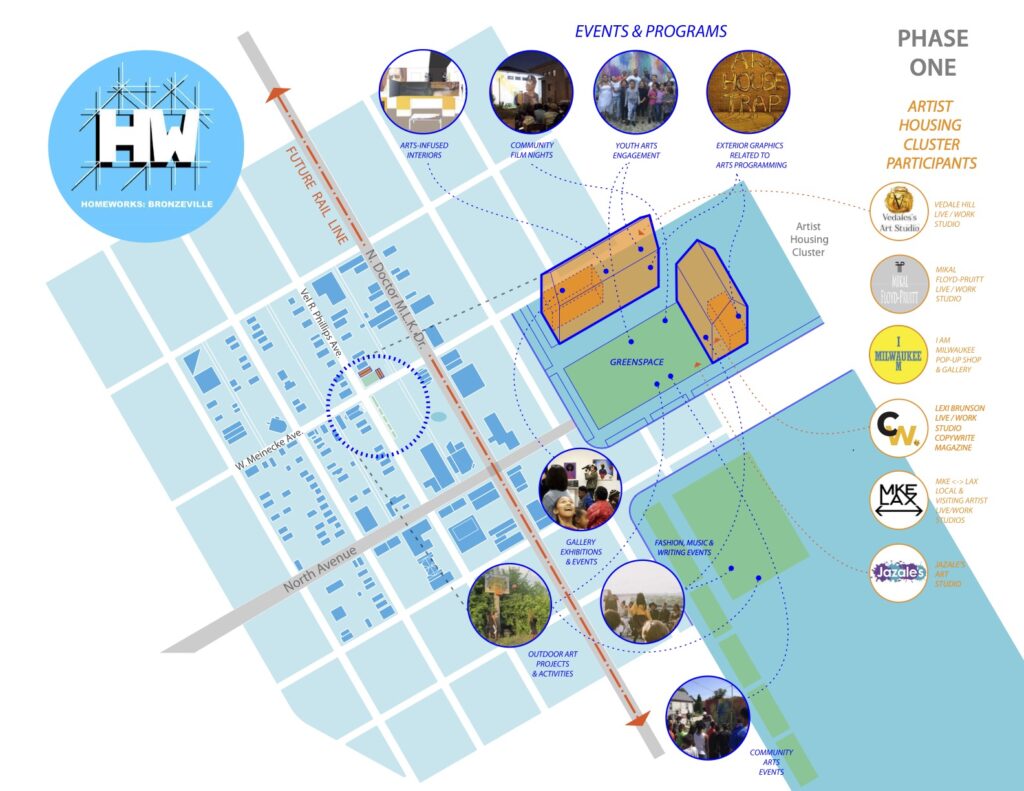
MFP: We are currently developing our second property, which Lexi is going to utilize as her live/workspace. So that’s the next immediate step, and that rehab is underway. And so that’s really going to start expressing that cluster effect, as the first phase is going to be around the corner from Vedale’s house. And Lexi works with us on media and creative consulting. So, you’re already seeing the collaboration and utilization of resources and communal economy happening with even just the first two properties. And after that would most likely be my live/workspace. We’re also interested and activating green space, so we got the property adjacent to Vedale’s space and the property that we will be inhabiting. Unfortunately, we have to demo the building. We initially wanted to rehab it as well. But through further inspection there is a major problem with the foundation, and we’ve realized we’re going to have to demo it. But the advantageous part of that result is that we will have a large, free space to do outdoor programming that will be even more visible to neighbors and community members that is permanently on display.
Part of the goal of HomeWorks: Bronzeville is to establish partnerships through philanthropy and financial institutions to develop a process and a pipeline that allows for artists to move into property ownership. If we look at the traditional mechanisms of loaning and assessment of financial preparedness, there are a lot of barriers to an artist being able to move into that position, even the way our income is looked at. A lot of us are getting money through contracts and it is coming in, in staggered pieces and that’s not traditionally what a bank wants to see—even if you make enough money. Financing institutions aren’t generally interested in community impact as a major goal or the vibrancy and stabilization of a neighborhood as a goal. That is where building relationships with foundations, other philanthropic institutions, and individuals who are able to give, allows us to start building this pipeline that will be beneficial to the cluster in the neighborhood and to the economy to move into ownership based on their merit as opposed to the financial rubric that has been laid out over the past, which frankly, in many cases is quite racist and bars Black people from home ownership. That is an important part of this—to figure out how we house people that generally have difficulty being housed, even if they’re a vital asset to the community. We hope for our successes to be recorded and communicated as a blueprint for people in other neighborhoods, other cities, and other countries to be able to look at it as a methodology for getting their artists housed to retain creative and social capital, which equals economic capital. Keep that in the hands of the artists. One thing we are looking at continuing to develop is the network in Bronzeville that right now is our goal to keep moving forward. We’re learning a lot as developers. We’re learning a lot as the landscape changes during COVID, and construction prices change, as the availability of workers has changed, and the availability of foreclosed properties has changed. So, we are moving forward, but we also have to be agile in our thinking and problem solving.
LT: Do you have any final words that you would like to impart in terms of your individual practices and/ or HomeWorks?
Sara Daleiden: I really appreciate this lens that you are bringing of the Black Lives Matter movement to the conversation and using our project as an example of addressing deep systemic change, but part of that is what I would call place-space change. And that movement has just done impressive and consistent work at the level of immediate protesting, often using bodies in various ways to create messaging, create a sense of presence. There’s just such an immediacy to it and a time sensitivity. Patrisse Cullors is a colleague of mine in Los Angeles and we have had some conversations over the course of Black Lives Matter. I think a lot about wealth generation for Black families, or about what it means to have a bricks and mortar presence. In Milwaukee, we see a focus on the reemergence of, or the rethinking of a Bronzeville cultural entertainment district. So, for me, it’s been important to my work with HomeWorks and with MKE<->LAX to take on racism and sexism and other kinds of key justice concerns. There has always been, with every step, a focus on Black culture in US lands, because I always want to connect the dots about how immediate action, like protest, and what we are doing, which is essentially about neighborhood development and city development. I was thinking about that with Milwaukee… I was born and raised outside of the city—I come from small-town farm culture—but I always had strong roots and family in the city throughout my childhood. I really became an artist here. Throughout my lifetime, there has always been an incredibly intense conversation around the way Milwaukee has practiced racism. I often think about Milwaukee as a Black city, or at least a city that has dominant population of people of color, but that’s not the way it’s been messaged my whole life. I’ve been craving a moment of generational shift that I think is happening now. And of course, generational shifts are erratic and slow in their processes, but doing this project becomes an expressive space for that.
Something that the women with Black Lives Matter have shown is that you have got to have that full range of action. Sometimes we do need to be in the street with our bodies, and then in other moments, we need to be in our homes, in private, gathering, and having political conversations. That can also be deeply impactful. It’s all part of the landscape that creates health and creates change and justice and we seek together… Before I got involved with MKE<->LAX it was more of a formal initiative for myself that could have been based in downtown Los Angeles for 20 years. But HomeWorks came out of that work. For me, it was America’s Black Holocaust Museum, which is our neighbor.
There have been a number of other projects in this country. Two colleagues that I have had conversations with for a decade or more are Rick Lowe with Project Row Houses and Theaster Gates with the Rebuild Foundation. Those projects are so important. But, for me, one of the important groups in Los Angeles is St. Elmo Village. The Sykes were important predecessors to all of us. [1] There is deep inspiration from seeing people—particularly Black leaders and artists—who have made multi-decade investments that involve property ownership and also have involved…for-profit or nonprofit entities, like Community Development Corporations… [These projects] open up more visibility on potential interchange and literally lay out options that other artists and different kinds of city and neighborhood leaders can look to. We just we need a toolbox. We have one historically, but with the generational shift, there’s a need to re-think it…So, we are hoping that our for-profit model—as a collaborative model with the government and other sectors interests—will add another possibility for people to consider who are doing this work.
LB: Another thing I wanted to emphasize is the fact that HomeWorks: Bronzeville is a development initiative, but it isn’t just a development company. The initiative [intends] to move this ideology forward at communal level. And so, it’s important to know that this is in direct correlation with problems we have all been experiencing. The entrepreneurs are these creators in the light… Having a brick and mortar or having residencies that can help you avoid displacement is vital to our existence and our livelihood. It should be noted that it’s not just an “us” problem. There are other people nationally and globally who are having the same kind of issue, and what we’re trying to say is that there is a method to address that. The work that we do directly correlates with all of that. Our practices are not disregarding the idea that displacement happens. It doesn’t disregard the idea that the creative industry is not supporting people as it should be, or that there is a lack of infrastructure in many of these metropolitan places for Black entrepreneurship and creativity. It is important to note that what we are doing is making a conscious decision to approach systemic issues with this kind of initiative, and that is why I decided to work with HomeWorks: Bronzeville. Knowing that I’m having these issues on an everyday basis and having this kind of practice where I’m pointing to my community, but there’s not an infrastructure to support that, or enough cultural or social infrastructure that allows me to make a living solely off of my creative practice. So, we are interrogating those things and it is important to note that that interrogation is a lifestyle. It’s not just to be seen, but to live.
MFP: My final thoughts are in relation to the support that we’ve been getting to move HomeWorks: Bronzeville forward. There’s been a handful of people who have really supported us becoming champions of the sort of change we’re trying to enact. Really, what we’re looking to produce is a paradigm shift. As Sara said, movements take multilateral efforts to produce those large shifts. We need to start looking differently at what we value in our city and what we value in our lives and culture and how we want to live, moving forward. What are better ways to be and what pieces of the old infrastructure do we need to change or replace in order to get to that space that makes our city the best place to live? And with that, I encourage those in the position to harness capital as an element of this change, to think boldly with us, to think expansively, and to think creatively as to how they can contribute financial support to something that is looking to tackle issues in a novel fashion. I want to call out to philanthropists to let the spirit of delving into the unknown be something that guides your giving, because if we stick to the same systems that we’ve been trying to generate change through for the last many hundreds of years, we’re going to be stuck with the same issues that we have now. It’s going to take new solutions. It’s going to take new collaboration. It’s going to take a new rejuvenated spirit to tackle these difficult systemic issues. And we need to examine philanthropy as a system that has issues embedded within it, that can be altered and adjusted to improve and to move forward more efficiently and effectively.
Mikal Floyd-Pruitt is a multi-disciplinary artist whose work includes visual art [in several mediums], music, and experience curation. Along with his personal art practice, he is also a community artist and cultural producer. In addition, he is the creator of I AM Milwaukee, a lifestyle brand that promotes unity, creativity, pride, and ownership in Milwaukee. Mikal studied film in college, earning a Bachelors of Art from Harvard University. As the mastermind behind large thematic art installations and experiences including Art House Trap and SPLASH!, Mikal advocates for the psycho-spiritual life of the citizenry and financial pathways art with infrastructure can create. As a creative and community member he uses aesthetics, performance, and programming to challenge the boundaries of society as we know it. Mikal’s dynamicity has allowed him to facilitate several community engaging experiences that cultivate art as an existential part of a place. He was the lead artist during his residency at the Spot 4MKE – a piloted public space in downtown Milwaukee – supported by Project for Public Spaces and co-directed HERE! CNI for the Choice Neighborhood Initiative with the local public housing authority. Vocalizing a need for artist supportive infrastructure, Mikal was featured on the cover artist housing report for Bronzeville, questioning public officials about vacant city-owned properties and community need for housing. As he interrogates policy as a creative he also offers open participation by way of ideation and innovation in the pursuit of social change.
Sara Daleiden facilitates civic engagement within developing landscapes, exercising arts and cultural exchange strategies based on over two decades of experience. She is a sought-after consultant for organizational development, real estate development, and economic development, as well as strategy, facilitation, and evaluation for numerous organizations and government bodies. She additionally has expertise working with artists and other entrepreneurs for creative placemaking, public art, artist residencies, and small business development. With headquarters in Milwaukee and Los Angeles, her initiative, MKE<->LAX, encourages local cultures to value neighborhoods, public space and social entrepreneurship, plus racial and gender equity. As a multifaceted creative, she received a Bachelor of Art Studio with a Sculpture Concentration from the University of Notre Dame and her Master of Public Art Studies at the University of Southern California (USC). She collaborates with the City of Milwaukee, the Greater Milwaukee Committee and other institutions and leaders to ensure the development of equitable places through the Milwaukee Method of Creative Placemaking. Milwaukee projects include the Beerline Trail Neighborhood Development Project (also known as the ARTery), Night Market on Wisconsin Avenue and HERE! CNI for a Choice Neighborhood Initiative.
Lexi S. Brunson is owner and active Editor-in-Chief of CopyWrite Magazine. With her role at CopyWrite, Lexi has built a creative network that not only showcases the creative community but serves as advocates and mentors for young writers, designers, and creatives. Obsessed with all things Urban, Lexi is a creative who believes in the importance of building community within the city. She is outspoken (as a tool), confident, and her creativity allows her to view the world WAY outside the box. She has a BFA in Interior Architecture & Design from MIAD, which has guided her research of Urban spaces and has helped her achieve a Masters degree in Media Studies from UW-Milwaukee. She has taught as an art programmer & instructor in the non-profit sector, worked as a professional interior designer in corporate America, and is currently an Associate Professor of Writing & Humanities at MIAD.
Laura Thompson is a Ph.D. student in Art History, Theory, and Criticism at the University of California, San Diego and a member of FIELD’s editorial collective.
Notes:
[1] The King Drive BID, or the Historic Dr. Martin Luther King, Jr. Drive Business Improvement District (BID8), was developed in 1992 as a resource to help support businesses and owners of property in the 8th district. According to their website, “The BID #8 aims to create clean, safe & vibrant King Drive with Neighborhood Ambassadors, special events, advocacy & marketing opportunities.” See: https://kingdriveis.com/.
[2] Rozzell and Roderick Sykes are the co-founders of St. Elmo Village, a LA-based Black art enclave and community center that has fostered generations artists and creatives since 1966. It has also served as a meeting space for the founders of the Black Lives Matter movement. See: https://stelmovillage.org/.

